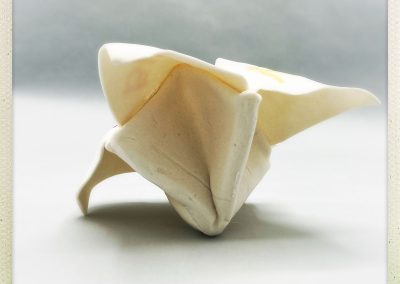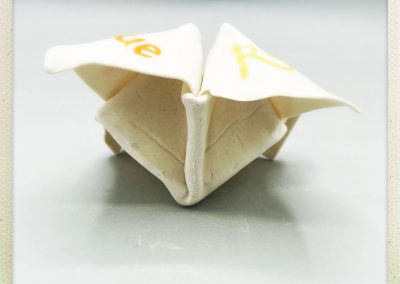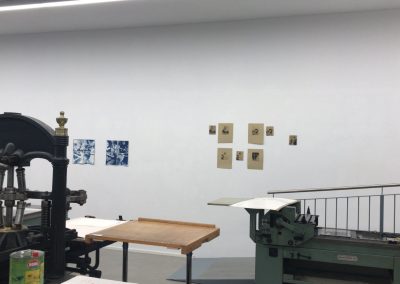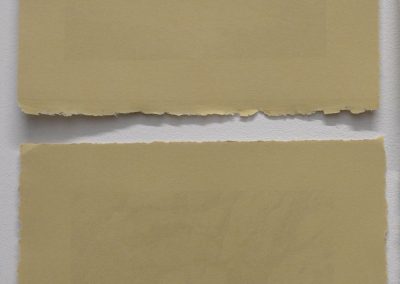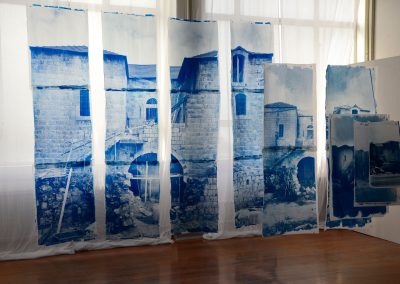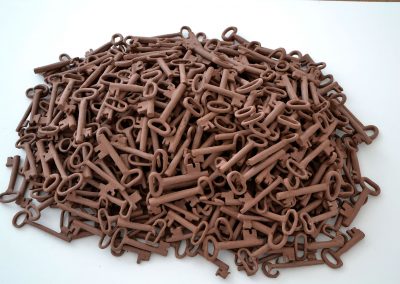2017-Present
Click image to view
The Absence of Presence
Edinburgh Printmakers Jan 2022 – March 2022
Absence does not mean forgetting
Beisan District 30
Beersheba District 4
Gaza District 49
Haifa District 51
Hebron District 16
Jaffa District 24
Jerusalem District 39
Nazareth District 4
Ramle District 60
Safad District 77
Tiberias District 25
Tulkarem District 17
Porcelain tablets made from Porcelain Paper clay, printed from hand-made embroidery.
In 1948, 424 villages and towns ceased to exist, and Palestine was erased from maps.
The inhabitants left out of fear, some forced out, some were killed in their homes, in their villages and on the roads.
Those who left, found themselves in refugee camps in other parts of Palestine: the West Bank and the Gaza Strip and in Egypt, Lebanon, Syria, Jordan and elsewhere.
Since then, more villages were ethnically cleansed and erased.
And it continues to this day.
Fragile embroideries
Grounded x10
Porcelain paper clay
…. I made a set of paper planes, made of porcelain paper clay… folding sanding firing utterly useless planes, divorced from their original function of flying…
Solace – Edinburgh Printmakers 2021
Someone I once knew lamp/madonna:
Toyobo plate/photpolymer gravure with polyester plate litho on BFK paper, 10 x 13 cm each.
The house was abandoned for many years, yet still felt inhabited. A layer of dust settled over all things. Though it was another country, someone I did not know, many of the items I saw were utterly familiar. I felt I know the person who once lived there, or in specific, the type of person he could have been: and uncle, a familiar character, a person to nod to: someone I once knew.
These are two of a series I will be working on in the future, for now, they stand alone.
WIP – fragile static fortunes III
Series include: Fortune tellers, paper planes, other objects to be added as they are made.
before long ago became long ago
Solo exhibition in the Druckwerk in Lustenau, an open printing workshop and exhibition space for contemporary printmaking.
Missing
polyester plate litho on BFK paper. 180 x 60 cm
The piece “missing” reflects that gaping hole we experience as Palestinians. The heart has been ripped out, and the image fades to nothing, with just the word missing left behind. we know something is missing, but the reality of it fades, and just the ache remains.
The complete image/piece is made of 8 prints going one way, and 8 going the other of a staircase in an abandoned olive store. As we are in the 8th decade of the loss of Palestine, 8 seemed appropriate.
Details – see RSA open 2019
before long ago became long ago - diptych
63cm x 63cm – diptych – photoetching on cotton with hand embroidery- unique prints
The Olive, iconic symbol of Palestine, of resilience and of resistance. the Olive store on the edge of a hill, with embroideries of cypress trees. Embroidery plays an integral part in Palestinian identity. Various motifs are found on village women’s dresses, identifying them as to which village or area they come from. These motifs on this diptych are from the Ramallah region, where the olive store sits, crumbling away from neglect.
Details – see RSA open 2020
Someone I once knew: lamp/ Madonna / chair / dolls
Toyobo plate/photpolymer gravure with polyester plate litho on BFK paper, 10 x 13 cm each
From a series of photographs taken during a residency in a remote part of central Italy.
With Cultural Documents: http://www.culturaldocuments.net/contributor/leena-nammari/
Embroideries
40 cm x 40 cm – made up of 4 x separate prints each 19cmx19cm . cyanotype with hand embroidery – edition of 3 each.
Part of a series of prints(cyanotype) made directly from hand embroidered pieces, these small pieces are directly referencing Palestinian embroideries found on village dresses.
from sacred ground I
Negative and positive Cyanotype diptych 85cm x 41cm
following residency at Filignano Molise Central Italy with Cultural Documents, I explored the landscape and found incredible similarities with the landscape of Palestine.. wild mint thyme sage, tiny cyclamen, terraced hills…
And yet, it was not home…
Selected Exhibitions
Cypress trees with the walls of Jerusalem
Cypress Trees with the walls of Jerusalem as patterns are not usually found together on an object. I have been trying to create new narratives and stories, a different visual language, using the embroidery motifs, both to celebrate and to mourn the loss of statehood, of village, and of landscape in the current political turmoil.
In the current turbulent climate surrounding Palestine and in particular Jerusalem with the Holy Sanctuary (Dome of the Rock-Al Aqsa) in a constant state of friction, my “utopia” of a peaceful city (Jerusalem – the city’s name itself indicates peace and sanctuary – is falling further and further away from its intended purpose, not peace, no utopia.
A tightly hung harvest
Forlorn Longing
A print from a photograph of cast ceramic keys that represent homes lost during the Palestinian Nakba and beyond. See the original keys in the MFA graduation Degree show photos in 2018.
missing – RSA open
Royal Scottish Academy, 2019/2020
Missing:
Polyester plate litho on BFK paper.
180 x 60 cm – made up of 16 separate prints – 26cm x 21cm each
We are what we are because of our strong connection with the land, through our language, our dialect, our food, our clothing.
The conflict has been going on since 1948, and the connection with home becomes more a “memory of home” and reality fades with time.
The piece “missing” reflects that gaping hole we experience as Palestinians. The heart has been ripped out, and the image fades to nothing, with just the word missing left behind. we know something is missing, but the reality of it fades, and just the ache remains.
The complete image/piece is made of 8 prints going one way, and 8 going the other of a staircase in an abandoned olive store. As we are in the 8th decade of the loss of Palestine, 8 seemed appropriate.
Third Space – Hiwar with Lujain Jamal
Wasps, Meadowmill, 2018
An initiative from curator Helen Angell-Preece.
From the press release written by Angell-Preece:
“….Contemporary culture, media and politics often represent global relations in a series of reductive dichotomies of opposition.
For a more useful dialogue to emerge, we must, believes Postcolonial theorist Homi Bhabha, focus instead on the space between. The space that opens up in the act of translation between two, often opposed cultures or languages, Bhabha describes, as The Third Space. It is, he says, a critical site for forging ‘new signs of identity and [re]negotiating cultural values’.
In order to help us explore and negotiate our way into this Third Space, curator Helen Angell-Preece brings together Palestinian-Scottish artist Leena Nammari, Saudi Arabian sculptor Lujain Jamal, and Palestinian cultural translator Dr Rana Abu-Mounes, to engage in an artistic, cross-cultural, translational and transnational dialogue, or Hiwar…..”
Swedish Hut
Edinburgh Printmakers: Paper to Gold, 2018
From EP website:
“To celebrate 50 years of printmaking excellence, Edinburgh Printmakers has invited 50 artists to each produce an anniversary print to be included in an astonishing commemorative portfolio of exemplary contemporary Scottish printmaking. Each artist has been invited to participate based on the quality of their practice and contributions to Edinburgh Printmakers studio throughout the years.“
www.edinburghprintmakers.co.uk/exhibition/from-paper-to-gold
I had used the Swedish Hut photograph as an example in most of my teaching for years while teaching at EP, and yet never editioned or printed a finished image. This was a chance to make something complete, to create an image with hand drawn and digital separations, using glitter and translucent colours.
We Do Need a Bigger Boat
Deluge, Edinburgh Printmakers, 2017
Medium: Screenprint – folded paper
Edition: 51
As Edinburgh Printmakers (EP) has grown over the past 51 years, it has also outgrown its wonderful eccentric former washhouse premises at Union Street. It has squeezed presses, members, courses, racks into ever smaller spaces, so we DO need a bigger space, hence: We DO need a bigger boat to float about in. Each boat is signed and has an edition number. They work as a collective, but also can be solitary and individual, as all printmakers are.
MFA Degree Show
Using cyanotypes, ceramics, bronze and prints, the show presented a subtle narrative littered with my eclectic curiosity in art of making. Having studied printmaking as an undergraduate, worked in print workshops, taught printmaking techniques, and made my own work in the vast umbrella called printmaking, I have been constantly pushing the boundaries of what is print.
The MFA has given me the option of exploring other media, pushing my thirst for knowledge down new avenues, and yet, in my mind, it is all part of the ethos of printmaking, never in a rigid sense, but in the fluid adaptability of the processes. I have found my life is vastly multi-layered, and therefore, really, all life is printmaking.
It Will Live
The floating images are of a house I have loved and known for 35 years.
I have been photographing it for 20.
I have been hoping it will survive the ravages of time, and not be demolished for a new, better functioning glass and steel and concrete structure.
I have been hoping it would live.
I remember I have loved it.
I remember I am anxious about it.
I think I remember what it looks like, but really, I don’t.
I do not want to know who owns it.
I do not want to know.
I just want it to live.
And it will live.
“Haneen”
A homesickness to a home to which you cannot return. A grief for the lost places of your past.
the 441 (four hundred and forty one) keys represent the 441 Palestinian villages that no longer exist. They have been wiped off the map, for 70 years, their inhabitants have had the “haneen” to go home, and hold onto the keys to the homes they had fled. And there is no home to go to.
Each of the unfired clay keys represent a minimum of 200 and a maximum of 1000 people per key in 1948. THIS is why the right of return is held so closely held. THIS is why the Palestinians struggle. THIS is why, in their various refugee camps, they long for home. 70 years later, they are still are in temporary places, and the haneen becomes stronger, not lesser, as their lives get harder, and their struggle is supplanted by other struggles, and obscured by greater powers.
This is the issue. And it will not go away.
The keys themselves are useless, they will open nothing, as they home they belonged to does not exist, but remains a symbol of haneen. But we have to think differently. The clay is malleable mud. It can be rewetted, reformed. We must hold onto it, but reform it into something that we can create meaning, and not just live off the thoughts it brings.
Biblical Jenga
Bronze cast and lasercut Palestinian olive wood.
Curse at will. Learn your curses well- weigh your words carefully.
Prefaced with “God” to obtain full potency.
![]() Yila’an illi Khallafak: Curse who created you
Yila’an illi Khallafak: Curse who created you![]() Yihiddak – Destroy you
Yihiddak – Destroy you![]() Yisamhak – Forgive you
Yisamhak – Forgive you![]() Yikhzeek – Humiliate you
Yikhzeek – Humiliate you![]() Yila’an Shiklak – Ruin your looks
Yila’an Shiklak – Ruin your looks![]() Yighuss Balak – Choke your peace of mind
Yighuss Balak – Choke your peace of mind![]() Yifdah A’ardak – Condemn your reputation
Yifdah A’ardak – Condemn your reputation![]() Yakhdak wi yirayyihni minnak – Take you and relieve me of you
Yakhdak wi yirayyihni minnak – Take you and relieve me of you![]() Yila’an abook – Curse your father
Yila’an abook – Curse your father![]() Yikhrib baiytak – ruin your home.
Yikhrib baiytak – ruin your home.
Fragile Declarations
Porcelain plaques made from deeply etched Zinc plates.
The words are overlapped, obscured, confused.
Yet, you can still pick out the critical urgent words. In 1970, Ghassan Kanafani was interviewed by an Australian reporter about the Palestinian struggle.
When asked “why not just talk”
He replied: “talk to whom? Talk about what? A kind of conversation between
The sword and the neck.”…”
His words still resonate 48 years later, and 46 since his assassination.
When poets writers and artists become worthy of assassination, they have something to say, they become feared by their oppressor.
Kanafani also said… “.. why struggle?:
To liberate our country, to have dignity, to have respect
To have our mere human rights, is something as essential as life itself”.




















